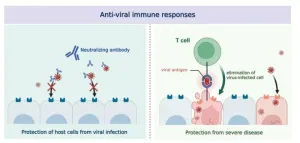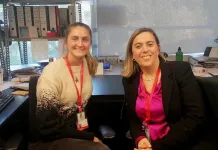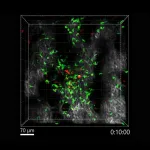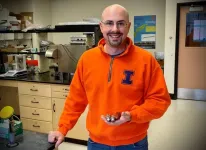(Press-News.org) Using CRISPR, an immune system bacteria use to protect themselves from viruses, scientists have harnessed the power to edit genetic information within cells. In fact, the first CRISPR-based therapeutic was recently approved by the FDA to treat sickle cell disease in December 2023. That therapy is based on a highly studied system known as the CRISPR-Cas9 genetic scissor.
However, a newer and unique platform with the potential to make large-sized DNA removals, called Type I CRISPR or CRISPR-Cas3, waits in the wings for potential therapeutic use.
A new study from Yan Zhang, Ph.D., Assistant Professor in the Department of Biological Chemistry at the University of Michigan Medical School, and her collaborators at Cornell University develops off-switches useful for improving the safety of the Type I-C/Cas3 gene editor. The study is published in the journal Molecular Cell.
Taking advantage of the arms race between bacteria and viruses that infect them (bacteriophages), the Zhang team develops CRISPR off-switches from anti-CRISPR proteins that phages have evolved to combat bacterial CRISPR immunity.
Anti-CRISPR proteins that inhibit Cas9 have been used in experimental settings to reduce CRISPR’s “off-target” effects. Such effects result from Cas9 acting on unintended, non-target parts of the body or genome and making undesired edits that may lead to adverse outcomes such as an increased risk of cancer.
“When editing human genome using CRISPR-Cas9, providing an inhibitor protein can helps mitigate off-target effects and increase the safety profile,” said Zhang. “This is because off-targets tend to occur when there is an excess of CRISPR reagents or that they linger in the cells for too long. Applying inhibitors to restrict the amount or duration of CRISPR action has proven to be effective in reducing off-target edits while maintaining on-target edits.”
The Zhang team set out to develop a robust off switch for the highly efficient Cas3 system they previously uncovered from Neisseria lactima, bacteria that live harmlessly in the human upper respiratory tract. Screening all known anti-CRISPRs that have been reported in literature as inhibitors for others Cas3 variants from distinct bacteria organisms they found two, AcrIC8 and AcrIC9, with a strong cross-reacting effect against the Neisseria Cas3.
Next the team wanted to know more about how they work because “how they work will inform what kind of Cas3-based technologies can be controlled by each anti-CRISPR,” said Zhang.
Using genetic and biochemical studies at U-M and cryogenic electron microscopy analysis performed at Cornell, they determined the mechanism of action and structure of AcrlC8 and AcrlC9 at the molecular level. Both proteins prevent the CRISPR-Cas3 machine from binding to its DNA target site but through slightly different mechanisms, they reported.
“To see this at an atonic level from Ke lab’s work is truly astonishing and they are employing a very clear strategy —competing with the DNA to be bound by the Cas machinery, a very effective way to block Cas protein function,” said Zhang.
Finally, the Zhang team provided key proof-of-concept evidence that each of these anti-CRISPR protein can serve as an off-switch for CRISPR-Cas3 in human cells. They can almost completely block two versions of the CRISPR-Cas3 technologies, one for large genome deletion and the other for gene activation, making them the first off-switches developed for any CRISPR-Cas3 gene editor.
“Cas3 with an off switch would be a safer way to engineer the genome,” said Zhang. Her lab plans to further develop CRISPR-Cas3 based therapeutics for various human diseases, with the newly discovered off switches, in collaboration with colleagues here at U-M Medical School.
Chunyi Hu, Ph.D. of Cornell University and Ph.D. student Mason Myers of U-M are first authors on the manuscript. “It has been extremely gratifying to watch Mason’s exponential growth as a budding young scientist. As a third-year PhD student in my group, he has already shown so much potential.” said Zhang.
Ailong Ke, Ph.D., Robert J. Appel Professor in Molecular Biology and Genetics at Cornell University is a co-corresponding author on this paper.
Paper cited: “Exploiting Activation and Inactivation Mechanisms in Type I-C CRISPR-Cas3 for 3 Genome Editing Applications,” Molecular Cell, DOI: 10.1016/j.molcel.2023.12.034
END
CRISPR off-switches: A path towards safer genome engineering?
New study provides proof-of-concept evidence for off-switch for CRISPR-Cas3
2024-01-19
ELSE PRESS RELEASES FROM THIS DATE:
Evolution of the human immune system in the post-Omicron era
2024-01-19
It has been 4 years since the start of the COVID-19 pandemic. SARS-CoV-2 has yet to be eradicated and new variants are continuously emerging. Despite the extensive immunization programs, breakthrough infections (infection after vaccination) by new variants are common. New research suggests that human immune responses are also changing in order to combat the never-ending emergence of new SARS-CoV-2 variants. Specifically, it has been discovered the immune system that encountered breakthrough infection by the Omicron variant acquires enhanced immunity against future versions of the Omicron.
A team of South Korean scientists ...
First therapeutic target for preserving heart function in patients with pulmonary hypertension
2024-01-19
A team led by Dr. Guadalupe Sabio at the Centro Nacional de Investigaciones Cardiovasculares (CNIC) in Madrid has discovered a possible therapeutic target for pulmonary hypertension.
The study, published in the journal Science Advances, identifies the first therapeutic target that can be modulated to preserve cardiac function in pulmonary hypertension, providing hope in the fight against this rare but fatal disease for which there is currently no cure.
Pulmonary hypertension is a condition of elevated blood pressure in the arteries that carry deoxygenated blood to the lungs. This increased pulmonary blood pressure puts the heart under continuous strain ...
Endless biotechnological innovation requires a creative approach
2024-01-19
Scientists working on biological design should focus on the idiosyncrasies of biological systems over optimisation, according to new research.
In a study, published today in Science Advances, researchers from the Universities of Bristol and Ghent have shown how exploring the unknown may be the crucial step needed to realise the continual innovation needed for the biotechnologies of the future.
Recognising the role of open-endedness in achieving this goal and its growing importance in fields like computer science and evolutionary biology, the team mapped out how open-endedness is linked to bioengineering practice today and what would be required to achieve it in ...
The secret life of CD4+ T cells: from helpers to melanoma fighters
2024-01-19
In the study led by the Peter Doherty Institute for Infection and Immunity (Doherty Institute) and published in Science Immunology, the researchers found that CD4+ T cells, traditionally called ‘helper T cells’ for their role in aiding the activation of other immune cells, are remarkably effective in controlling melanoma.
University of Melbourne’s Dr Emma Bawden, Postdoctoral Researcher at the Doherty Institute and lead author of the study, said this discovery challenges the conventional understanding of the role of CD4+ T cells in cancer immunity.
“Our ...
Study says ice age could help predict oceans’ response to global warming
2024-01-19
A team of scientists led by a Tulane University oceanographer has found that deposits deep under the ocean floor reveal a way to measure the ocean oxygen level and its connections with carbon dioxide in the Earth's atmosphere during the last ice age, which ended more than 11,000 years ago.
The findings, published in Science Advances, help explain the role oceans played in past glacial melting cycles and could improve predictions of how ocean carbon cycles will respond to global warming.
Oceans adjust atmospheric CO2 as ice ages transition to warmer climates by releasing the greenhouse ...
From snack to science: Innovative grant brings popcorn into the classroom
2024-01-19
URBANA, Ill. — In a few years, popcorn could become a standard element in science classrooms across Illinois and the nation. With funding from a new USDA grant, a University of Illinois Urbana-Champaign crop scientist and collaborating educators are developing a popcorn-based curriculum to reinforce concepts around agricultural science, artificial intelligence, biotechnology, computer science, genomics, research methods, and more for 4-H and high school students.
The funding may be new, but Tony Studer has proselytized ...
The case of a patient with multiple myeloma cured after hepatitis treatment reveals that this cancer can be caused by viruses, and opens up new treatment options
2024-01-19
Hepatitis C and B viruses are one of the causes of this type of cancer –a most frequent on in blood–, and the pathologies that precede it, known as gammopathies.
Early identification of an infection with these viruses can help doctors to prescribe appropriate treatment and prevent it from leading to malignant pathologies.
The research has been discussed in an editorial article in the journal Haematologica
A few years ago, a patient was cured of multiple myeloma after being treated for hepatitis C, astounding researchers from the group led by Joaquín ...
Why family businesses get more from women leaders
2024-01-19
Family businesses account for more than 70 percent of global GDP, and survey data shows that they are much friendlier to female leadership: up to 55 percent have at least one woman on their board and 70 percent are considering a woman for their next CEO. Experts have attributed this outlier gender parity to an emphasis on long-term strategies or family values. But a new study, published in the Strategic Entrepreneurship Journal, suggests that women’s success as leaders in family businesses is deeply rooted in how employees interpret their leadership style.
“Family firms tend to focus on being inclusive ...
Wobbling particles in the sky
2024-01-19
The atmosphere contains many tiny solid particles. Scientists from the Max Planck Institute for Dynamics and Self-Organization (MPI-DS) and the University of Göttingen in collaboration with the Centre national de la recherche scientifique (CNRS) in France and the university of Gothenburg, Sweden, now studied how such non-spherical particles settle in air. For this, they used a new precision apparatus equipped with high-speed cameras and a novel particle injection mechanism. Using a 3D-printer, they created particles of different shapes resembling discs of thickness as low as 50 micrometer and rods of length as high as 880 micrometers. Thanks to this setup, they could observe that particles ...
Hiring globally mobile, highly specialized workers after their firm’s failure can be a strategic move, despite a loss of legitimacy
2024-01-19
New research published in Global Strategy Journal identifies globally mobile workers with highly specialized skills as a strategic hiring strategy, due to the workers’ legitimacy and mobility after being laid off by a failure of their former employer. The study shows that laid-off workers experience comparatively high legitimacy loss if they worked in the unit or geographical location where other workers were suspected of being responsible for the corporation’s failure. As a result, their bargaining position with a prospective employer is weaker, even if their special skills ...
LAST 30 PRESS RELEASES:
Brain immune cells may drive more damage in females than males with Alzheimer’s
Evidence-based recommendations empower clinicians to manage epilepsy in pregnancy
Fungus turns bark beetles’ defenses against them
There are new antivirals being tested for herpesviruses. Scientists now know how they work
CDI scientist, colleagues author review of global burden of fungus Candida auris
How does stroke influence speech comprehension?
B cells transiently unlock their plasticity, risking lymphoma development
Advanced AI dodel predicts spoken language outcomes in deaf children after cochlear implants
Multimodal imaging-based cerebral blood flow prediction model development in simulated microgravity
Accelerated streaming subgraph matching framework is faster, more robust, and scalable
Gestational diabetes rose every year in the US since 2016
OHSU researchers find breast cancer drug boosts leukemia treatment
Fear and medical misinformation regarding risk of progression or recurrence among patients with breast cancer
Glucagonlike peptide-1 receptor agonists and asthma risk in adolescents with obesity
Reviving dormant immunity: Millimeter waves reprogram the immunosuppressive microenvironment to potentiate immunotherapy without obvious side effects
Safety decision-making for autonomous vehicles integrating passenger physiological states by fNIRS
Fires could emit more air pollution than previously estimated
A new way to map how cells choose their fate
Numbers in our sights affect how we perceive space
SIMJ announces global collaborative book project in commemoration of its 75th anniversary
Air pollution exposure and birth weight
Obstructive sleep apnea risk and mental health conditions among older adults
How talking slows eye movements behind the wheel
The Ceramic Society of Japan’s Oxoate Ceramics Research Association launches new international book project
Heart-brain connection: international study reveals the role of the vagus nerve in keeping the heart young
Researchers identify Rb1 as a predictive biomarker for a new therapeutic strategy in some breast cancers
Survey reveals ethical gaps slowing AI adoption in pediatric surgery
Stimulant ADHD medications work differently than thought
AI overestimates how smart people are, according to HSE economists
HSE researchers create genome-wide map of quadruplexes
[Press-News.org] CRISPR off-switches: A path towards safer genome engineering?New study provides proof-of-concept evidence for off-switch for CRISPR-Cas3





